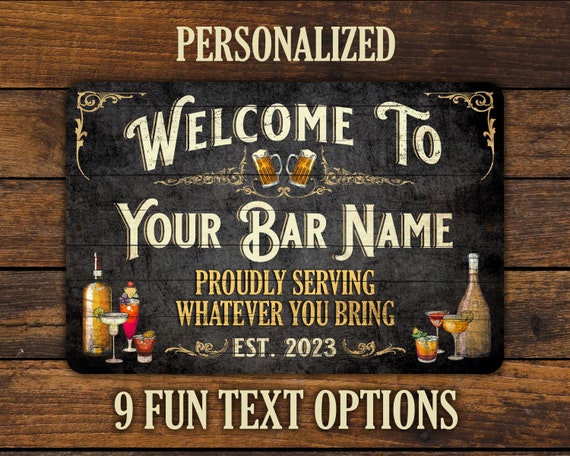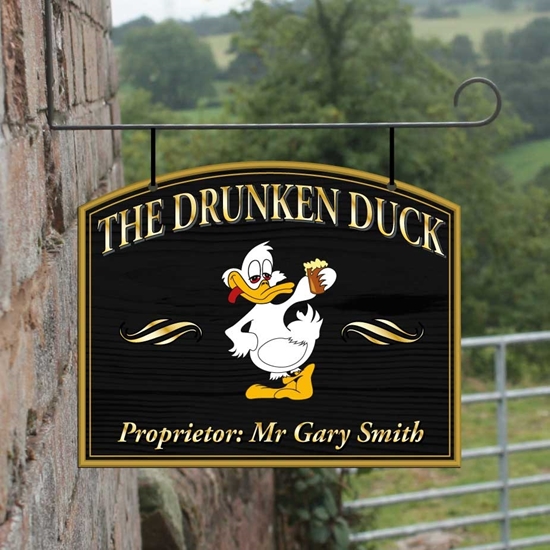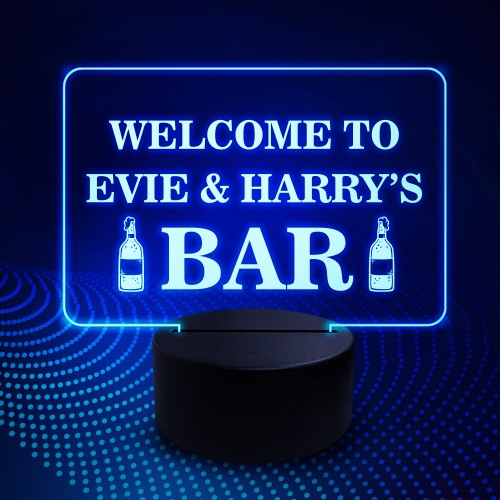Best Suggestions To Deciding On Gin Bar Signs
Wiki Article
How Do Bar Signs Differ In Size?
According to their intended use, placement and design aesthetic the bar signs differ in terms of size. Here's how different sizes can impact bar signs with regard to functionality and design. Large Signs
The function of an Arrow is to draw attention and function as a focal-point.
Uses: Exterior signage as main branding signs or walls with features.
The placement is typically placed above entrances, large walls, or even outside the bar. It will attract patrons.
Examples: huge neon signs vintage-style signs, mural-type signs.
2. Medium Signs
The goal is to add information, or enhance the decor without taking up the space.
They can be used for menu boards as well as advertising displays and directional signs.
The location of the sign: Ensure that the signage is in a visible location, but not too overwhelming.
Examples: Medium-sized chalkboards that advertise daily specials, signs made of metal with the logo of the bar, or themed decorative signs.
3. Small Signs
The purpose is to provide precise details or subtle decorative elements.
They can be used for table signs, small decorative items or labels.
Placement : on tables, shelves or in displays in which close-up viewing is expected.
Examples are: Table number signs, small frames of quotes, or menus for drinks cards.
Size Aspects
Visibility
Signs that are large: These signs can be observed from a distance and draw attention of passers-by. They also signalize the location of an establishment.
Medium Signs: They balance the need for information while maximizing space. They provide it without overwhelming decor.
Small Signs: Ideal for intimate information or close-up details. Improves the experience for customers by putting them in the eye of the customer.
Proportion
Signs must be proportional to the area so as to not overwhelm tiny areas. Most suitable for large or open spaces.
Medium Signs: They work well in the majority of interior spaces, offering flexibility in the positioning.
Smaller signs: Ideal to add details and to fit into smaller spaces without clutter.
Impact
Signs of a large size: Makes a bold and strong statement. This is an important factor in branding. Signs for bars are used to set a certain tone.
Medium Signs are able to strike an equilibrium between design and visibility, contributing to the overall ambience while conveying vital information.
Small Signs: They add elegance and details to the visual experience, enhancing it.
Practicality
Large Signs: These signs require substantial mounting solutions, and are more expensive due to their size.
Medium signs are simpler to install and reposition. They also offer flexibility with regard to design modifications.
Small Signs: Very adaptable and simple to update or replace suitable for dynamic environments like bars that change menus or promotions.
Functionality
Large Signs : They are designed to increase visibility, attract attention and practicality.
Medium Signs provide both essential information as well as aesthetic appeal.
Small Signs can be used to convey detailed information. They are also utilized to enhance the look of your theme.
The right size of an appropriate bar sign is dependent on its purpose, design of the space, and the impact desired on the patrons. Balancing these elements ensures that the signs contribute effectively to the bar's atmosphere and operational needs. Take a look at the top hanging signs for more advice including personalised outdoor bar signs, outdoor personalised bar sign, garden pub signs, pub signs to buy, personalised pub signs for garden, pub wall sign, personalised cocktail sign, novelty bar signs, buy bar signs, staying inn sign and more.

How Are Bar Signs Placed And Mounted?
Bar signs vary in terms of mounting and installation based on their type size, weight, location and the purpose for which they are intended. This article will give a detailed look at the various mounting and installation alternatives for bar sign. Wall-Mounted Signs
Features: Can be fixed directly to walls.
Methods:
Screws and anchors Anchors and screws: This is typical for signs that are heavier that are made of metal, for example wood.
Adhesive strip: for temporary or lighter installations as well as signs (foamboard or acrylic).
Brackets can be used to hang signage that extends beyond the wall.
Uses: Indoor decor, menu boards, directional signs.
Benefits: Secure and versatile display.
The drawbacks of this product are: It may damage walls and is hard to place.
2. Hanging Signs
Particularities: Suspended from overhangs or ceilings.
Methods:
Chains: strong and flexible great for signs with heavy weights.
Cables: More slim. They are often used for contemporary designs.
Rods: Provide a rigid support structure.
Uses: Ceiling decor, directional signs, overhead promotional signs.
Vertical space is very noticeable and the design options are endless.
Disadvantages
3. Freestanding Signs
The main characteristic is that it is not fixed to any structure or supports, but supported by a support or base.
Methods:
A-Frame is foldable and portable often used to promote on sidewalks.
Pedestal Stands: Stable base, ideal for indoor use.
Post and Panel is a well-known term for large, permanent signs.
Uses: Outdoor advertising, indoor directional signs, promotional displays.
Benefits: Simple to move, portable, and versatile.
Disadvantages: Can be bulky, requires the use of floor space.
4. Window Signs
The main characteristics are that it is directly attached to windows.
Methods:
Suction Cups are ideal for signs with light, since they are simple to remove and put in.
Adhesive Vinyl can be used for decals or graphics.
Static Cling is permanent but it is reusable. It's also simple to make use of.
Uses: Promoting message, branding, and operating hours.
Benefits: Maximizes windows, and is highly visible from outside.
Disadvantages: Limited by size of window, may be affected by sunlight.
5. Signs with backlights and edges that are lit
Features: Include lighting into the sign structure.
Methods:
Wall Mounting with Electrical Connections: Needs a secure connection and electrical hookups.
Suspended with Power Cables Combines hanging technique with integrated lighting.
Examples include high-visibility branding for menu boards, or decorative elements.
Benefits: Improved visibility and attractive illumination.
Disadvantages
6. Temporary and portable Signs
Specifications Designed to facilitate rapid and simple setting up.
Methods:
Pop-up Stands: Light and compact.
Banner Stands: Roll-up or retractable designs.
Uses: Promotions, events Decorate for seasonal events.
Benefits: Simple transport and fast set-up.
Disadvantages: Less durable, might not be as sturdy.
7. Magnetic Signs
Magnetic force is used to join the magnet.
Methods:
Magnet Strips: They are applied on the back of the sign.
Magnetic Boards: Signs attach to a surface made of metal.
Examples include menu boards, announcements which are temporary or can be changed.
Benefits: Easy to replace. No permanent fixtures are required.
Limitation to magnetic surfaces can cause it to be less secure.
8. Projection Signs
Specificities include the use light to project images or text.
Methods:
Mounted projectors can be attached securely on ceilings or walls.
Portable Projectors: Positioned on stands or other surfaces.
Utilized for: Promotions, events Displays that are dynamic.
Benefits There is no physical signage required, content can be easily changed.
Disadvantages
Tips for mounting and installation
Weight and Size
Heavy Signs: Require more durable mounting solutions such as screws and anchors.
Light Signs: You can make use of less complex methods such as suction cup or strips of adhesive.
Durability
Utilize more durable mounting methods to create permanent signs.
Temporary Signs: Opt for methods that permit easy removal and changing positions.
Location
Indoor: More flexible with materials, techniques and weather resistance.
Outdoor: Needs weatherproof materials and a secure mounting order to stand up to elements.
Aesthetics
Concealed mounting: This option offers a cleaner appearance by concealing the hardware.
Signs can be accentuated with decorative hardware.
Accessibility
Simple access to changes: This is important for menu boards, signs and other signage which require regular changes.
Security: Signs are secured from being easily tampered and taken.
Take note of these aspects when selecting the best mounting and installation methods for your bar. You can be certain that they are in line with both aesthetic and functional requirements. Take a look at the top rated cocktail bar sign info for blog advice including large personalised bar signs, personalised metal pub signs, pub sign design ideas, bar sign outdoor, personalised garden pub sign, cocktail bar sign, pub sign design ideas, bar sign hanging, bespoke bar signs, pub signs to buy and more.

What Are The Differences Between Bar Signs In Regulations Terms?
Signs for bars are subject to a myriad of rules that are imposed by state, local and federal authorities to ensure safety for the public as well as aesthetic standards and compliance with the zoning laws. The rules for signs at bars vary. There are regulations regarding the size and location of signs.
Zoning law: This is a set or rules that determine where signs may be placed, their height, size and distances from the property line and other buildings.
Historical Districts. The restriction can be imposed to certain areas in order preserve their historical character. These restrictions can limit the size, shape and design of signs.
2. Illumination Restrictions
Light Pollution: To try to reduce light pollution, it's possible to control the brightness, the colour, and duration of the illuminated signs.
Safety concerns: Signs should not produce glares that cause distraction to pedestrians and drivers.
3. Signage Content
Alcohol Advertising: Alcohol advertising is banned in certain states. This includes images and material that might appeal to minors, or promote excessive drinking.
Health Warnings - Laws may require the prominent display of health warnings and the signs pertaining to smoking cigarettes or drinking alcohol.
4. Historic Preservation Regulations
Architectural Compatibility. Signs that are located in historic districts should be in line with the architectural style and character of that area. In most cases preservation committees or boards are required to approve signs.
Design and Materials - Restrictions may be placed on the materials, design, or color schemes to ensure historical integrity.
5. Sign Permitting Process
Permits are needed: The owners of bars need permits to install or modify signs. This could include submitting drawings, paying fees, as well having approval from the local authorities.
Code Compliance: In order to ensure public security and accessibility Signs must be in compliance with construction codes, safety regulations, and accessibility standards.
6. Repair and removal of signs
Maintenance Requirements. It is up to the bar's owner to make sure that signs are maintained in good repair solid and structurally sound without dangers and that they are in accordance with the regulations.
Signs abandoned: There may be rules that govern the removal or abandonment of abandoned or decrepit signs in order to maintain the aesthetic value of the area and avoid pollution.
7. Digital Signage Regulations
Content Restrictions There are laws which regulate the content of digital signs. They can prohibit certain types of content, such as offensive images or flashing lights.
Operational Limits Regulations may restrict the brightness of digital signs and frequency, as well as motion. reduce visual obstructions.
8. Penalties and Enforcement
Inspections Local authorities conduct regular inspections to ensure that signage regulations are adhered to and issue citations for violators.
Penalties may include fines or citations for non-compliance. It is also possible to be ordered to remove signs or change their design or face legal actions.
9. Sign Process
Variance applications: Bar owners who wish to deviate their signage from the rules can do it by submitting a request for the variance. Justification should be provided as well as any negative effects on public security or appearance should be considered.
Public Input: Certain issues may require public hearings, or input from residents, neighboring property owners, or business associations.
10. Community Input and Engagement
Public Consultation Some jurisdictions engage community members to help develop regulations. This can be done through public meetings, surveys or stakeholder consultation processes.
Sign regulations could have community Benefits. Sign regulations may include provisions that enhance the appearance of signs, promote local business, or help to revitalize communities.
Bar owners who know and follow signage regulations can make sure that their signs attract customers, contributing positively to their community, while also meeting legal standards. This reduces the chance of legal issues, fines or penalties. Follow the top rated homepage about bar signs for home for blog advice including personalised home bar signs, the staying inn sign, personalised garden bar signs, home bar pub signs, pub signs for home bars, garden pub signs, personalised pub signs for garden, small pub signs, the staying inn pub sign, bar signs for home and more.
